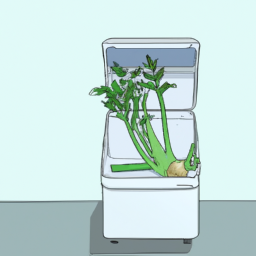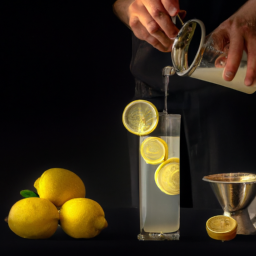As someone who regularly drinks celery juice, I recognize the importance of keeping it fresh and tasty. One common question from fellow celery juice enthusiasts is, “How long can celery juice stay fresh in the fridge?”
The answer to this question depends on several factors, such as the freshness of the celery, the method of juicing, and the storage conditions.
In this article, I will explore the shelf life of celery juice, the factors that affect how long it lasts, and provide tips for storing celery juice to ensure it stays fresh for as long as possible.
Whether you’re a seasoned celery juice drinker or just starting out, understanding how to properly store and maintain the freshness of your juice is crucial for both taste and safety.
Key Takeaways
- Proper storage of celery juice involves refrigeration temperature below 40°F (4°C) in an airtight container, and consumption within 24-48 hours for optimal freshness.
- The shelf life of celery juice depends on factors such as freshness, juicing method, and storage conditions. Celery juice can last up to 3-4 days in the refrigerator with proper preservation techniques.
- Wilted, yellowed, or brown celery leaves indicate that the celery is no longer fresh. Changes in color, smell, or taste indicate celery juice has gone bad and should be disposed of properly.
- To ensure celery juice stays fresh, it’s best to drink it within 24-48 hours of juicing, store it in an airtight container, and keep it refrigerated.
The Shelf Life of Celery Juice
So, how long can we keep that delicious celery juice in the fridge before it goes bad? The answer depends on how well we preserve the juice and our refrigeration techniques.
Proper juice preservation techniques include using airtight containers, filling the container to the brim to prevent air exposure, and refrigerating it immediately after making it. These techniques will help keep the juice fresh for a longer period.
Refrigeration techniques also play a crucial role in extending the shelf life of celery juice. Keeping the juice at a temperature below 40°F (4°C) slows down the growth of bacteria and yeast, which are the primary causes of spoilage. It’s best to store the juice in the main compartment of the refrigerator where the temperature is the most stable.
By following these techniques, we can keep celery juice fresh for up to three days. However, several factors can affect how long celery juice lasts, and we’ll explore those in the subsequent section.
Factors That Affect How Long Celery Juice Lasts
You may be surprised to learn that the acidity level of your homemade celery juice can significantly impact its shelf life, with a pH level below 4.6 increasing the chances of spoilage.
Other factors affecting the shelf life of celery juice include the level of oxidation, the presence of bacteria, and the temperature at which it’s stored.
Here are some factors that can affect how long celery juice lasts:
- The pH level of the juice
- The presence of bacteria in the juice
- The level of oxidation
- The temperature at which it’s stored
- The quality of the celery used to make the juice
To ensure that your celery juice lasts as long as possible, it’s important to store it in ideal conditions.
This means keeping it in an airtight container in the refrigerator, away from direct sunlight or heat sources.
Additionally, it’s best to consume celery juice within 24-48 hours of making it to ensure optimal freshness.
In the next section, we’ll explore some tips for storing celery juice to extend its shelf life even further.
Tips for Storing Celery Juice
When storing your homemade celery juice, it’s important to keep it in an airtight juice container to maintain its freshness for a longer period. Air exposure can cause the juice to oxidize, leading to a change in color and taste.
Moreover, the juice container should be made of glass or BPA-free plastic to avoid contamination and the transfer of harmful chemicals from the container to the juice.
Another essential factor to consider when storing celery juice is temperature control. The juice should be stored in the refrigerator in the coldest part, which is usually the back. This will help to slow down the growth of bacteria and prevent spoilage.
It’s also important to note that celery juice should be consumed within 24-48 hours of juicing to get the maximum nutritional benefits.
If you notice any changes in the color, smell, or taste of your celery juice, it’s a sign that it has gone bad. In the next section, we’ll discuss the signs that indicate your celery juice has spoiled and how to avoid consuming contaminated juice.
Signs That Your Celery Juice Has Gone Bad
To know if your celery juice has spoiled, look out for changes in its color, smell, and taste. If it looks cloudy, smells off, or tastes sour, it’s time to toss it out.
Here are some ways to prevent celery juice spoilage and how to properly dispose of expired celery juice:
- Store your celery juice in an airtight container. This will help keep it fresh for longer by reducing exposure to oxygen.
- Keep your celery juice refrigerated at all times. Bacteria grow rapidly at room temperature, so it’s important to keep your juice chilled.
- Use fresh celery and drink your juice within 24-48 hours of making it. The longer it sits, the more likely it is to spoil.
If you do find that your celery juice has gone bad, it’s important to dispose of it properly. Pour it down the sink or toilet and rinse the container thoroughly before recycling or throwing it away.
Now that you know how to tell if your celery juice has gone bad and how to properly dispose of it, let’s move on to the next section about how to tell if your celery is fresh.
How to Tell If Your Celery Is Fresh
Feeling unsure about the freshness of your celery? Here’s a quick and easy way to tell if it’s still good to use. Check the leaves of the celery. If they are wilted, yellowed, or brown, it’s a sign that the celery is no longer fresh. Another way to check is to snap a piece of celery in half. If it breaks cleanly and with a crisp sound, then it’s fresh. If it bends or feels rubbery, then it’s no longer fresh.
To ensure that your celery stays fresh for longer, there are a few ways to preserve its freshness. One common mistake when storing celery is to leave it in the plastic bag that it comes in from the grocery store. Instead, remove the celery from the bag and wrap it in a damp paper towel before storing it in a plastic container or a resealable bag. This will help to keep the celery hydrated and prevent it from drying out. Another way to preserve celery freshness is to store it in the crisper drawer of your refrigerator, where the temperature and humidity levels are optimal for keeping vegetables fresh.
Now that you know how to tell if your celery is fresh and how to preserve its freshness, let’s move on to the benefits of drinking celery juice.
Benefits of Drinking Celery Juice
You’ll be amazed at how drinking a glass of fresh, green celery juice each morning can give your body the boost it needs to power through the day, like a shot of espresso for your health. Celery juice has been making waves in the health and wellness world recently, with proponents claiming that it can help alleviate a range of health issues, from digestive problems to skin conditions. Some even suggest that a celery juice fast can help reset your body and provide a range of benefits, similar to those offered by alternative medicine.
One of the main benefits of drinking celery juice is its ability to reduce inflammation in the body. Celery is rich in antioxidants and other anti-inflammatory compounds, which can help alleviate symptoms of conditions like arthritis and other inflammatory diseases. Additionally, celery juice is a great source of vitamins and minerals, including potassium, vitamin K, and folate. These nutrients can help support overall health and wellbeing.
So if you’re looking for a simple and effective way to improve your health, consider giving celery juice a try. In the next section, I’ll share some tips on how to make your own fresh celery juice at home.
How to Make Celery Juice
If you’re looking to add a healthy habit to your morning routine, try whipping up a batch of homemade celery juice using these simple steps.
First, wash and chop a bunch of celery into small pieces. Then, using a juicer, extract the juice from the celery. Finally, strain the juice to remove any pulp or fibers.
Drinking celery juice comes with a host of benefits. Not only is it a great source of hydration, but it also contains important nutrients like potassium, vitamin K, and folate. Additionally, celery juice has been shown to have anti-inflammatory properties and may help improve digestive health.
With so many benefits, it’s no wonder that celery juice has become a popular health trend. If you’re interested in trying it out, there are plenty of recipes available online to help you customize the taste to your liking.
To incorporate celery juice into your diet, try drinking a glass each morning before breakfast. You can also use it as a base for smoothies or add it to other juices for an extra nutrient boost.
With a little creativity, you can easily make celery juice a regular part of your healthy eating routine.
How to Incorporate Celery Juice into Your Diet
One way to easily incorporate celery juice into your diet is by mixing it with your favorite fruits and vegetables in a smoothie, which can provide a tasty and nutritious start to your day. Celery juice benefits include reducing inflammation, improving digestion, and boosting hydration.
Drinking celery juice daily on an empty stomach is said to enhance its benefits, but it can also be consumed throughout the day as a refreshing and healthy beverage option. However, it’s important to note that celery juice should be consumed within a few days of being juiced in order to obtain the maximum nutritional benefits.
Celery juice can last up to 3-4 days in the refrigerator, but it’s best to drink it within 24-48 hours of juicing. To ensure that your celery juice stays fresh, store it in an airtight container and keep it refrigerated. One way to reduce waste when making celery juice is by using the leftover pulp in recipes such as soups or vegetable broth.
Another option is to compost the pulp, which can add valuable nutrients to your soil. By implementing these practices, you can enjoy the benefits of celery juice while also reducing your environmental impact.
Ways to Reduce Waste When Making Celery Juice
Make a positive impact on the environment by using the leftover pulp from your celery juice in delicious recipes or composting it for nutrient-rich soil. Not only does this help reduce waste, but it also provides a sustainable solution for your celery consumption.
Here are some ways to make the most of your celery pulp and juice leftovers:
-
Use the pulp in recipes: Celery pulp can add a fiber boost to baked goods like muffins or bread. It can also be used as a base for dips and spreads, such as hummus or guacamole.
-
Compost the pulp: Celery pulp is rich in nutrients and makes a great addition to compost piles. It can also be added directly to soil as a natural fertilizer.
-
Use leftover juice: If you have leftover celery juice, try using it as a base for smoothies or as a seasoning in soups and stews. It can also be used to marinate meats or vegetables.
In addition to reducing waste, practicing sustainable celery consumption can also have a positive impact on the environment. Consider growing your own celery using organic practices, or purchasing organic celery from local farmers. By choosing organic options, you can help reduce the use of harmful pesticides and support sustainable farming practices.
Frequently Asked Questions
Can I freeze celery juice for longer storage?
Yes, I recommend freezing celery juice for longer storage as an alternative method. It can be stored in an airtight container for up to 6 months. Thaw in the fridge and shake well before drinking.
Is it safe to consume celery juice past its expiration date?
Consuming celery juice past its expiration date poses potential health risks due to the growth of harmful bacteria. Signs of spoilage include a sour smell, slimy texture, and discoloration. Always discard expired juice.
Does adding lemon juice or other ingredients affect the shelf life of celery juice?
When adding lemon juice, the acidity may slow down bacterial growth, but it won’t extend the shelf life significantly. The benefits of drinking celery juice are best enjoyed on an empty stomach in the morning.
Can I store celery juice in a plastic container instead of a glass jar?
I prefer storing my celery juice in a glass jar to maintain its consistency. However, plastic container storage alternatives are also an option. Just be aware that the juice’s consistency may change slightly due to contact with plastic.
How do I prevent my celery juice from separating or becoming watery during storage?
To prevent oxidation and separation, store celery juice in an airtight glass container in the fridge. It’s best to consume within 24 hours, but adding lemon or lime juice can extend its shelf life.
Conclusion
In conclusion, as someone who regularly drinks celery juice, it’s important to know how to properly store and identify when it has gone bad. The shelf life of celery juice can vary depending on factors like temperature and exposure to air. It’s generally safe to consume for up to three days when stored in the fridge. However, signs of spoilage such as a foul odor or change in texture should be heeded as a warning to discard the juice.
Drinking celery juice has numerous health benefits, such as aiding in digestion and reducing inflammation. When making celery juice, it’s important to minimize waste by finding creative ways to use the leftover pulp.
Overall, incorporating celery juice into your diet can be a healthy and refreshing addition. Like a crisp morning breeze, celery juice can invigorate and revitalize your body.
Ilana has been a vegan for over 10 years. She originally made the switch for health reasons, but soon found herself becoming more and more passionate about the ethical and environmental implications of a vegan lifestyle. Ilana is the author of The Graceful Kitchen, a blog all about veganism. She loves to cook up delicious and nutritious vegan meals, and share her recipes with others who are interested in leading a cruelty-free life. Ilana is also a strong advocate for using whole foods as the foundation of a healthy diet, and believes that going vegan is one of the best ways to achieve this.










